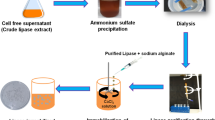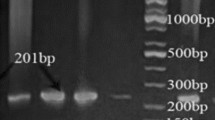Abstract
Pseudomonads have been reported for their metabolic, nutritional and ecological versatility, which motivated us to prospect the metabolic profile of a lipolytic strain Pseudomonas aeruginosa SL-72. The strain SL-72 was found to produce high levels of lipase and pectinase (1,555.62 IU/mL and 1,490.33 IU/mL, respectively), esterase and amylase, besides low levels of xylanase, proteinase and cellulase. The strain also tested positive for different plant growth-promoting traits—production of ammonia, hydrogen cyanide, siderophores, phosphate solubilization, nitrate reduction and antifungal activity. The high levels of activity of aryl sulphatase, alkaline phosphatase and fluorescein diacetate hydrolase makes it a useful strain for enhanced nutrient cycling in soil. The strain SL-72 produced rhamnolipids, a biosurfactant and its production was enhanced when starch was used as carbon source (0.256 g/L) and utilized polycyclic hydrocarbon compounds viz. anthracene, phenanthrene, pyrene, fluorene and its mixture. The multifaceted nature of the culture illustrates its promise in bioremediation, industry, besides its use as an inoculant.


Similar content being viewed by others
References
Altschul SF, Gish W, Miller W, Myers EW, Lipman DJ (1990) Basic local alignment search tool. J Mol Biol 215:403–410
Bailey MJ, Biely P, Poutanen K (1992) Inter laboratory testing of methods for assay of xylanase activity. J Biotechnol 23:257–270
Bakker AW, Schippers B (1987) Microbial cyanide production in the rhizosphere in relation to potato yield reduction and Pseudomonas spp-mediated plant growth stimulation. Soil Biol Biochem 19:451–457
Banat IM (2000) Les biosurfactant, plus que jamais solicites. Biofutur 198:44–47
Barben J, Hafen G, Schmid J (2005) Pseudomonas aeruginosa in public swimming pools and bathroom water of patients with cystic fibrosis. J Cyst Fibros 4:227–231
Benincasa M (2007) Rhamnolipid produced from agroindustrial wastes enhances hydrocarbon biodegradation in contaminated soil. Curr Microbiol 54:445–449
Bernfeld P (1955) Amylases, alfa and beta. Methods Enzymol 1:149–58
Blanco A, Pastor FIJ (1993) Characterization of cellulase-free xylanases from the newly isolated Bacillus sp. strain BP-23. Can J Microbiol 39:1162–1166
Bragger JM, Daniel RM, Morgan HW (1989) Very stable enzymes from extremely thermophilic archaebacteria and eubabacteria. Appl Microbiol Biotechnol 31:556–561
Bushnell LD, Haas HF (1941) The utilisation of certain hydrocarbons by microorganisms. J Bacteriol 41:653–673
Cappuccino JG, Sherman N (2002) Microbiology: a laboratory manual, 6th edn. Benjamin Cummings, Menlo Park, CA, pp 133–198
Cardenas J, Alvarez E, de Castro-Alvarez MS, Sanchez-Montero JM, Valmaseda M, Elson SW, Sinisterra JV (2001) Screening and catalytic activity in organic synthesis of novel fungal and yeast lipases. J Mol Catal B Enzyme 14:111–123
Charles TC, Nester EW (1993) A chromosomally encoded two-component sensory transduction system is required for virulence of Agrobacterium tumefaciens. J Bacteriol 175:6614–6625
Christensen WB (1946) Urea decomposition as a means of differentiating Proteus and paracolon cultures from each other and from Salmonella and Shigella types. J Bacteriol 52:461–466
Colwell RR, Grigorova R (1987) Current methods for classification of microorganisms. 19:31
Cooper DG, Goldenberg PG (1987) Surface-active agents from two Bacillus sp. Appl Environ Microbial 53:224–229
Dáes J, De Maeyer K, Pauwelyn E, Höfte M (2010) Biosurfactants in plant—pseudomonas interactions and their importance to biocontrol. Environ Microbiol Reports 2:359–372
Desai JD, Banat IM (1997) Microbial production of biosurfactants and their commercial potential. Mcrobiol Mol Biol Rev 61:41–64
Dye DW (1962) The inadequacy of the usual determinative tests for identification of Xanthomonas spp. NZT. Sci 5:393–416
El-Saadany RMA, Salem FA, El-Manawaty HK (2006) A high yield of amylase from Aspergillus niger by effect of gamma irradiation. Starch 36:64–66
Franken LPG, Marcon NS, Treichel H, Oliveira D, Freire DMG, Dariva C, Destain J, Oliveira JV (2009) Effect of treatment with compressed propane on lipases hydrolytic activity. Food Bioprocess Technol 3:511–520
Gajju H, Bhalla TC, Agarwal HO (1996) Thermostable alkaline protease from thermophilic Bacillus coagulans PB-77. Ind J Microbiol 36:153–155
Ghose TK, Bailey HJ, Bisaria VS, Enari TM (1983) Measurement of cellulase activities. Final Recommendations, Commission of BioTechnol. International Union of Pure and Applied Chemistry, pp 1–13
Green VS, Stottand DE, Diack M (2006) Assay for fluorescein diacetate hydrolytic activity: optimization for soil samples. Soil Biol Biochem 38:693–701
Greenberg AE, Trussel RR, Clesceri LC (1985) Standard methods for examination of water and waste water, 16th edn. American Public Health Association, Washington D.C.
Haritash AK, Kaushik CP (2009) Biodegradation aspects of polycyclic aromatic hydrocarbons (PAHs): a review. J Hazard Mater 169:1–15
Hegeman GD (1966) Synthesis of the enzymes of the mandelate pathway by Pseudomonas putida. I- Synthesis of enzymes by the wild type. J Bacteriol 91:1140–1154
Holt JG, Krieg NR, Sneath PHA, Staley JT, Williams ST (1994) Bergey’s manual of determinative bacteriology, 9th edn. Lippincott Williams & Wilkins, Philadelphia, pp 1–787
Jaeger KE, Dijkstra BW, Reetz MT (1999) Bacterial biocatalysts: molecular biology, three-dimensional structures and biotechnological applications of lipases. Annu Rev Microbiol 53:315–351
Jain DK, Collins-Thompson DL, Lee H, Trevors JT (1991) A drop-collapsing test for screening surfactant-producing microorganisms. J Microbiol Methods 13:271–279
Jain P, Jain S, Gupta MN (2005) A microwave assay for lipases. Anal Bioanal Chem 381:1480–1482
Kim E, Zylstra GJ (1995) Molecular and biochemical characterization of two meta-cleavage dioxygenases involved in biphenyl and m-xylene degradation by Beijerinckia sp. strain B1. J Bacteriol 177:3095–3103
Kok RG, Christoffels VM, Vosman B, Hellingwerf KJ (1993) Growth-phase-dependent expression of the lipolytic system of Acinetobacter calcoaceticus BD413: cloning of a gene encoding one of the esterases. J Gen Microbiol 139:2329–2342
Kouker G, Jaeger KE (1987) Specific and sensitive plate assay for bacterial lipases. Appl Environ Microbial 53:211–213
Makkar RS, Cameotra SS (1998) Production of biosurfactant at mesophilic and thermophilic condition by a strain of Bacillus subtilis. J Ind Microbiol 20:48–52
Miller GL (1989) Use of dinitrosalicylic acid reagent for determination of reducing sugars. Anal Chem 31:426–428
Minjares-Carranco A, Trejo-Aguilar BA, Guillermo A, Viniegra-Gonzalez G (1997) Physiological comparison between pectinase producing mutants of Aspergillus niger adopted either to solid state fermentation or submerged fermentation. Enzyme Microb Technol 21:25–31
Mukherjee S, Das P, Sen R (2009) Rapid quantification of a microbial surfactant by a simple turbidometric method. J Microbiol Meth 76:38–42
Nie M, Yin X, Ren C, WangY XuF, Shen Q (2010) Novel rhamnolipid biosurfactants produced by a polycyclic aromatic hydrocarbon-degrading bacterium Pseudomonas aeruginosa strain NY3. Biotechnol Adv 28:635–643
Ong PS, Gaucher GM (1973) Protease activity by thermophilic fungi. Can J Microbiol 19:129–133
Pelczar MJ, Bard RC, Burnett GW, Conn HJ, Demoss RD, Euans EE, Weiss FA, Jennison MW, Meckee AP, Riker AJ, Warren J, Weeks OB (1957) Manual of microbiological methods. Soc. Amer. Bacteriol. McGraw Hill Book Company, Inc., NY, USA, pp 315
Pikovskaya RI (1948) Mobilization of phosphorus in soil connection with the vital activity of some microbial species. Microbiologiya 17:362–370
Saleem M, Arshad M, Hussain S, Bhatti AS (2007) Perspective of plant growth promoting rhizobacteria (PGPR) containing ACC deaminase in stress agriculture. J Ind Microbiol Biotechnol 34:635–648
Sarlangue J, Brissaud O, Labreze C (2006) Clinical features of Pseudomonas aeruginosa infections. Arch Pediatr 1:13–16
Schwyn B, Neiland JB (1987) Universal chemical assay for the detection and determination of siderophores. Anal Biochem 160:47–56
Shaharoona B, Naveed M, Arshad M, Zahir ZA (2008) Fertiliser dependent efficiency of Pseudomonads containing ACC-deaminase for improving growth, yield and nutrient use efficiency of wheat (Triticum aestivum L.). Appl Microbiol Biotechnol 79:147–155
Sharma A, Jansen R, Nimtz M, Johri BN, Wray V (2007) Rhamnolipids from the rhizosphere bacterium Pseudomonas sp. GRP(3) that reduces damping-off disease in chilli and tomato nurseries. J Nat Prod 70:941–947
Siegmund I, Wagner F (1991) New method for detecting rhamnolipids excreted by Pseudomonas sp. during growth on mineral agar. Biotechnol Tech 5:265–268
Soriano M, Blanco A, Díaz P, Pastor FIJ (2000) An unusual pectate lyase from a Bacillus sp. with high activity on pectin: cloning and characterisation. Microbiology 146:89–95
Tabatabai MA, Bremner JM (1970) Arylsulfatase activity of soils. Soil Sci Am Proc 34:225–229
Tabatabai MA, Bremner JM (1969) Use of p-nitrophenyl phosphate for assay of soil phosphatase activity. Soil Biol Biochem 1:301–307
Tian L, Ma P, Zhon J (2002) Kinetics and key enzyme activities of phenanthrene degradation by Pseudomonas mendocina. Process Biochem 37:1431–1437
Verma S (2011) Isolation and characterization of lipase producing bacterial strains from oil-contaminated soils. Ph.D. Thesis, Banasthali University, India
Wang Q, Fang X, Bai B, Liang X, Shuler PJ, Goddard WA, Tang Y (2007) Engineering bacteria for production of rhamnolipid as an agent for enhanced oil recovery. Biotechnol Bioeng 98:842–853
Wei J, Zhou Y, Xu T, Lu B (2009) Rational design of catechol-2,3-dioxygenase for improving the enzyme characteristics. Appl Biochem Biotechnol 162:116–126
Zhao Z, Wong JW (2009) Biosurfactants from Acinetobacter calcoaceticus BU03 enhance the solubility and biodegradation of phenanthrene. Environ Technol 30:291–299
Zhu L, Zhang M (2008) Effect of rhamnolipids on the uptake of PAHs by ryegrass. Environ Pollut 156:46–52
Acknowledgements
The authors are thankful to Banasthali University and Division of Microbiology, Indian Agricultural Research Institute for extending the facilities for undertaking the experimental work.
Author information
Authors and Affiliations
Corresponding author
Electronic supplementary material
Fig. 1. Screening of Extracellular enzyme activity of P. aeruginosa SL-72: (a) Lipase. (b) Esterase. (c) Xylanase. (d) Cellulase. (e) Proteinase. (f) Pectinase. (g) Amylase. (h) Acrylamidase.
Fig. 2. In vitro screening of PGP traits of lipolytic strain P. aeruginosa SL-72: (a) NH3 production. (b) Siderophore production. (c) Phosphate solubilisation. (d) HCN production. (e) Inhibition of Macrophomnia Phaseolina by P. aeruginosa SL-72.
Fig. 3. Screening of P. aeruginosa SL-72 for its biosurfactant production potential: (a) β-hemolysis. (b) Rhamnolipid production.
Fig. 4. Catechol-2,3 dioxygenase activity and PAH utilization pattern of P. aeruginosa SL-72 (a) Catechol-2,3 dioxygenase. (b) Anthracene. (c) Fluorene. (d) Phenanthrene. (e) Pyrene. (f) PAH mixture.
ESM 1
(PDF 295 kb)
Supplementary Table 1
(DOCX 16 kb)
Rights and permissions
About this article
Cite this article
Verma, S., Prasanna, R., Saxena, J. et al. Deciphering the metabolic capabilities of a lipase producing Pseudomonas aeruginosa SL-72 strain. Folia Microbiol 57, 525–531 (2012). https://doi.org/10.1007/s12223-012-0163-0
Received:
Accepted:
Published:
Issue Date:
DOI: https://doi.org/10.1007/s12223-012-0163-0




